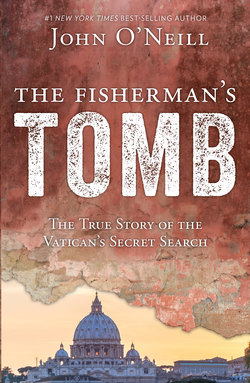Читать книгу The Fisherman's Tomb - John O'Neill - Страница 13
На сайте Литреса книга снята с продажи.
ОглавлениеChapter Three
Peter
“Jesus said to them, ‘Come after me, and I will make you fishers of men.’ Then they abandoned their nets and followed him.” — Mark 1:17–18
Who was the Apostle Peter? What were his defining characteristics? What was there that would be helpful either in identifying his mortal remains (if located) or the things associated with him? Had he really come to or remained in dangerous Rome in the age of the bloodthirsty Emperor Nero?
He was by most accounts a simple, middle class, middle-aged Jewish fisherman named Simon, of no particular note, when he met Christ near the sea of Galilee. He had been born in the village of Bethsaida in Galilee (now in Syria) around the turn of the first millennium A.D. From the Gospel account, we know his father’s name was John, and he had a brother named Andrew who also became an apostle of Jesus. He was married, and Christ cured his mother-in-law of a sickness. His in-laws lived in the delightful coastal city of Capernaum. Some accounts say he had three children.
He owned his own boat on the Sea of Galilee. Peter was likely a robust and powerful man hardened by the sea and the need to throw out and pull in nets. He was all in all a typical first-century small entrepreneur without any particular import, who would have long since totally vanished from history and been forgotten but for his meeting with Christ circa A.D. 30.
Responding positively to a practical stranger’s invitation to become “a fisher of men,” he abandoned his home, his boat, his business, and probably his family to follow and become the leading disciple of a man whom the world would regard as an idealistic, totally impractical, quixotic dreamer. That man was called Jesus. To mark the fisherman’s new work, Jesus also gave him a new name, one which was uncommon in ancient times25 — Petros, or Peter — which means “rock.” This name is given to no one else in Scripture. Although his faith often deserted him, Peter was the first to claim Jesus as the long-awaited Messiah (see Matthew 16:13). In turn, Christ gave him “the keys to the kingdom.”
The road the fisherman followed from Jesus’ invitation on the shore of the Sea of Galilee would have many twists and turns. He would travel far from simple Galilee over the next three decades, and would come to be venerated as the first pope, one of the greatest Christian saints, and even recognized as a great leader for the Christians by some Muslims.26
Was he the sort of courageous person who would actually come to and stay in Rome while he knew himself to be the target of the wrath of Nero? Or would he have fled the emperor’s notorious cruelty? The answer is both. The Peter who three times denied even knowing Christ in his greatest hour of need, was the same person who sought to defend Christ against a crowd of arresting soldiers. Later, the same man who once tried and failed to walk on water would appear twice before the Sanhedrin — the same tribunal that had seized Christ — excoriating them for their cowardly and evil treatment of Jesus. Peter was clearly capable both of defying the emperor to his face on his home ground and fleeing. He was much the type of man who would first flee and then, mortified by his cowardice, return to face death.
Yet tradition holds that he stayed in Rome (or returned) and was crucified upside down around the year 65. If this ancient story proved true, what would an archeological excavation find? Most likely the relics would be those of a man in his sixties with a robust physique, bearing marks of crucifixion. The Jewish turncoat general Josephus,27 who joined the Romans to destroy his own people, wrote of how the Roman soldiers at play would crucify Jewish captives in various different positions for their amusement. Tacitus described how Nero in particular crucified Christians upside-down. Peter’s relics — if they somehow survived two thousand years — would likely show marks of violent crucifixion.
Finally, if the old legends that Christians found and preserved the remains of the first pope were actually true, surely they would have left some symbols of respect to mark the site — perhaps a cloth wrapping or hidden inscriptions (hidden, since they themselves would continue to be persecuted for 250 years after Nero). What clues might archeologists search for? Because the name “Peter” was largely unknown before Christ gave it to Simon, any discovered reference to “Petros” from the first century almost surely referred to the pope. Drawings of key symbols, particularly with a “P” or “Pe” for Petros, would be other clear ways of representing Peter.
Many secularists denied that Peter ever went to Rome. In addition, Martin Luther claimed that nobody knew where in Rome the bodies of Saints Peter and Paul were located or whether they were even there at all.28 If the physical remnants of Peter’s presence and death in Rome could be found, it would tend to validate numerous Christian and Catholic beliefs. It could provide the power of archeological and physical evidence to support early Christian writings. On the other hand, if the search failed to find evidence of Peter, it would tend to validate the skepticism of Luther and many others toward the Catholic Church and Catholic accounts of early Christian history in general.
If Peter’s relics could somehow be identified, they could answer these questions across the long millennia separating his death from Pius’s search. Were the descriptions of him accurate? Did he really go to Rome during the persecution of Nero? Was he crucified upside down and buried in Rome? Did his friends honor him, and how?
